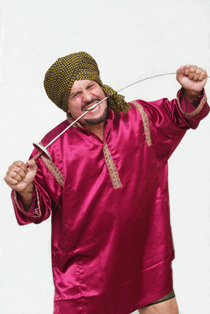I hear that Tiger Jeet Singh is now a successful business person based in Canada. His real self is a rational man with cool judgments. Once on the ring, he becomes a wild beast, with a very unique fighting style.
In professional wrestling there are certain protocols. Beautiful girls dressed in kimonos would present flower bouquets to the fighters. The referee will explain the rules, and the fighters shake hands. Tiger Jeet Singh would have none of that.
Before the gong sounds, Tiger Jeet Singh is already on the offensive. Everything occurs out of the blue, without hesitation, with full vigor. He would swing his saber towards Anotonio Inoki, and the two fighters would fall out of the ring. Once out of the ring, it is a total chaos. Chairs would fly. Tiger Jeet Singh would chase Antonio Inoki, and the spectators would flee. The spotlight follows the fighters. The announcer would shout "Please take care! Please take care!". The announcer's cries of warning add fuel to the excitement.
After a while, the gong rings. Then the announcer would calmly say "now the match has begun". It is a very strange announcement. It is as if the nasty doings of Tiger Jeet Singh, clearly violating the rules, are being blessed in retrospect. It has been all O.K. The match is already in full motion.
The fighting style of Tiger Jeet Singh, in which he ignores the preparatory protocols of the match and just "goes for it" the moment he springs onto the ring, fascinated and thrilled me as a child. I have been trying to imitate the style in real life ever since.
When you are attending a conference, or on a committee, there are people who like to say polite but meaningless things. I ignore the mannerism, and just go straight to the essence of matters. The spirit of Tiger Jeet Singh is in me. I don't have a saber, but I have the burning heart.

Classic. Tiger Jeet Singh showing his emotions.



